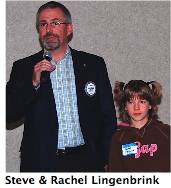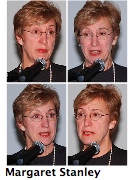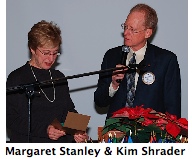THE FRIDAY PROGRAM: Measuring the Quality of Our Health Care – More Than a “Gut Feeling” (Margaret Stanley) | Friday Potpourri | Holiday Breakfast, December 15 | Silent Bell Ringing | World Community Service: Project Village, Xeucalvitz | Golfing With Elves | Paul Harris Giving: Jeff Cashman | Penny LeGate's Ethiopia Documentary | Student of the Month: Kate Newman | Web Fun
The invocation and pledge were led by Roger Allington, and Chuck Barnes greeted visiting Rotarians and guests. John Martinka reported on the success of the Anniversary Dinner. The BBRC Players interviewed and then found the “real Santa” after screening several fraudulent candidates for next Friday’s (December 15) Holiday Breakfast. BBRC Player Wendi Fischer urged all members and families to come to this special event and to let the club know how many children would be attend so that we will have enough gifts for everyone.
Peter Stadelman reported that every child’s wish on the Giving Tree will be granted, and that wonderful gifts are being donated and delivered by the generous members of our BBRC. Howard Johnson thanked all past volunteers and reminded everyone that there will be a work party again this weekend and throughout the month of December. World Community Service: Project Village, Xeucalvitz
The development includes the building of a road and last year’s project — bringing clean water to every home in the village. The mortality rate before the “clean water” project was 50%. This past year, no child died. This year’s project is “sanitation” and the construction of latrines. The cultural exchange activity that Rachel was very involved in putting on was a “birthday party” that included games like “Pin the Tail on the Donkey” and water fights. CLICK HERE TO VIEW THE XEUCALVITZ PRESENTATION.
Don Chandler presented Jeff Cashman with his five sapphire pin and Paul Harris honors for his donation of $6,000 to the Rotary International Foundation. In addition, Jeff has donated another $1,000 in memory of his father Ben, who was also a dedicated Rotarian. Congratulations, Jeff! Student of the Month: Kate Newman
Kate has a GPA of 3.98 and she is secretary of the National Honor Society. Her current classes include: Advanced Placement Calculus, Literature, Mathematics, and Science. She is also enrolled in Advanced Drawing and Painting. Her academic goals are to attend a small liberal arts university, travel, and perfect her language skills in Spanish. An outstanding athlete and a 3-year starter on the Varsity Soccer and Track and Field teams, Kate is also an All King County honoree in Track and Field (2004-06), and she received an Honorable Mention in both 2005 and 2006 in Soccer. Community Service is Kate's passion, and she went on a mission trip to Rwanda this past summer where she and the team of volunteers from Rowanda Partners built a pre-school with members of the Bellevue Sunrise Rotary Club. They also repaired homes, counseled girls and women engaged in prostitution, and worked on many other family and individual health needs. During the school year, Kate volunteers with Lake Hills Family Connections Center, Jubilee’s REACH Christmas Gift Giving, and the Bellevue Youth Theatre. The Program:
Health care is intensely personal. Think of the last time you were a patient. Maybe your spouse, child or parent was the patient. What was that like? Words like “informed and confident” probably don’t come to mind. For most people, being a patient means feeling vulnerable, unsure or overwhelmed. Now, consider the last time you handled an administrative aspect of health care. Maybe as an employer buying health benefits. Or as a family selecting insurance or sorting out medical bills. What was that like? In any of these situations, how many of you had useful information about the quality, cost and value of your health care options? (Raise hands) Not many. (Maybe none.) It’s hard to be objective and analytical when you’re sick. Most people trust their physicians to get them through illnesses and injuries, and it’s nearly impossible to make objective decisions with little or no information. Conventional wisdom says that we have some of the best doctors and hospitals in the world, and the latest medical technology, but we are 30th in the world in life expectancy, right behind Cuba, and we spend 50% more than the next most expensive country. And, unlike most other developed countries, we have 45 million people who are uninsured.
Something has to give. Fortunately, there are practical improvements we can make in health care. These improvements, which I’ll describe, combine the powerful influences of information and incentives. First, We All Want Quality Health Care. “Quality Health Care” is defined by the Institute of Medicine as safe, rimely, effective, efficient, equitable and patient-centered. It keeps us healthy and gets us well if we are sick. But, there is no information about who best provides quality care. Even doctors and hospitals don’t have information to compare how well they are doing. Second, We All Want Value From Our Health Care Dollar You know that health insurance premiums continue to rise. The cost of employer-sponsored family coverage has increased by 87% since 2000. Over the same period, inflation rose a cumulative 18% and wages went up 20%. By 2008, General Motors expects to spend more on health care in the U.S. than on its hourly-worker payroll. Last year, Starbucks announced it is spending more on health care than on coffee. No wonder employers tell us that their “hair is on fire.” Many employers are shifting costs to employees. But, shifting the cost burden doesn’t fix the underlying problem. In fact, when we talk of health care ‘cost control,’ it's time to acknowledge that simply shifting costs won’t work. The real issue is health system performance. The incentives in health care aren’t working to produce the results we need.
Let’s face it: incentives do influence behavior. We will get cost under control when we change incentives. Incentives need to reward those who provide effective care, reduce unnecessary services, avoid medical errors, and increase patient safety. The consumer plays a big role, too, so incentives need to drive patients to effective care and decisions that improve their health. Our vision at the Alliance, is to improve quality of care and control costs. In order to drive this improvement, we all need better information. Today We Lack Information About Local Health Care Value Think about the last time you bought a car, a computer or purchased airline tickets. I’ll bet most of you knew where to look for information on the quality and cost of different options. And you spent time comparing choices and using the information to know what questions to ask before making a decision. How about the last time you needed to choose a doctor or hospital? Or even knowing what to ask during your annual check-up? Consumers in the Puget Sound area recently told us that they don’t have useful information to compare the quality of doctors and hospitals. 94% said that they would likely use such a comparison report to help them make health care decisions. It’s difficult for patients to engage in their health care when they don’t have useful information. We DO Know that there is Room for Improvement Recent research has revealed a disturbing picture of wide variation and inconsistency. According to the RAND Corporation, in the Puget Sound area about 40% of the care provided is inconsistent with basic standards for effective care as defined by the medical community. In the rest of the country, it’s slightly worse. Let’s get the basics right. Too many patients with diabetes aren’t getting regular blood sugar tests or an annual foot exam or eye exam to catch and avoid complications. Complications of diabetes cause amputations, blindness and heart attacks. Too many people take expensive brand name prescriptions instead of more affordable generics. For many drugs, the FDA has approved generics that are ‘equivalent’ or chemically the same. The brand name drug isn’t better than the generic, so every extra dollar paid for the brand-name drug is wasted. Nearly $400 billion — almost one-third of the total spent on health care each year — pays for care that is not good quality.8 What would happen if quality care were consistently provided to all patients? If you compare the national average rates of diabetes and blood pressure control against the rates achieved for the top 10 percent of patients, that translates to an estimated 20,000 to 40,000 preventable deaths and one to two billion dollars in avoidable medical costs.9 Every step toward better quality saves lives and saves dollars. That’s where employers like you and others in the Alliance come in. Employers play an important role in health care. Locally, employers are at the table with doctors, insurers and patients to work on the cost and quality problem. We are doing it without pitting doctors against health plans; employers against employees; and the business community against the health industry. Effective collaboration defines the Puget Sound Health Alliance. We are a non-profit, non-partisan coalition of more than 125 public and private employers, clinics, hospitals, unions, health plans, and consumers. Our members include Boeing, Starbucks, REI, WAMU, union trusts, and public employers like the State of Washington, and King, Pierce and Snohomish counties. Our board is over one half purchasers, and the remaining seats are filled by doctors, hospitals, health plans and consumers. Employers have the majority of the seats on the board because they are the ones paying for most of the health care. We got started in 2005 and our focus is on five counties: Snohomish, King, Kitsap, Pierce and Thurston. Nearly all of our funding comes from our members. In total, the Alliance represents more than one million covered people, not counting health plan enrollment. With the health plans, it’s probably over half the population in Puget Sound. By working together and leveraging our combined market share, the Alliance will have a stronger impact on the health care system than any one organization could have by working alone. We have learned from what our Alliance members are doing that works so we can apply best practices to our efforts. For example:
In addition to learning from best practices, the Alliance is forging new ground for the region in two key strategic areas. Strategy One: Transparent Information Starting next year, we will publish the first community-wide report comparing the performance of local clinics and hospitals. We’ll start with measures of basic quality care for people with diabetes, heart disease, low back pain, and depression, in addition to measures for prescription drugs and prevention. The report will be updated and expanded every quarter. Ultimately, it will compare quality, efficiency and patient experience for all local doctors and hospitals. Several communities around the country produce public reports comparing health care quality. We are learning from their experience. We are also one of four communities in the country who have been awarded grants for the “Aligning Forces for Quality” project funded by the Robert Wood Johnson Foundation. The public report for Puget Sound will be designed so that doctors and hospitals can use the results to see how they compare to their peers. Knowing who does well allows doctors to identify best practices and learn from each other so everyone can improve. The concept is that a rising tide will lift all boats. The report will give the rest of us — employers and consumers — information to allow us to choose those providers who perform well. The Alliance is also supporting doctors and hospitals to use health care information technology, such as electronic medical records. This year, thanks to First Choice Health and the State Health Care Authority, one million dollars in grants were given to small clinics and hospitals for electronic medical records which they otherwise could not afford. Strategy Two: Reward Quality Health Care Through Aligned Incentives Instead of paying more for doing more, we should reward doctors and hospitals for “doing better.” The public report comparing health care performance will be a very strong incentive. Research shows that public reporting is very effective in motivating doctors and hospitals to improve. The performance report is based on clear definitions of quality care, consistent with national standards and confirmed by local physician leaders. The Alliance is relying on the medical community to define quality because they are the experts. Reports from our “clinical improvement teams” are available to anyone interested. There are no “black boxes” at the Alliance. Everyone has a responsibility to do their part. Employers and health plans can apply the performance report results to reward doctors for doing well. This can take many forms, including public recognition, encouraging consumers to choose higher quality providers, and changing reimbursement to reward quality, often called ‘pay for performance.’ Patients can use the quality reports when making health care decisions. This includes talking with their doctor about effective care, then following their doctor’s advice. What’s Next for the Alliance The initial health care performance report is scheduled for the spring of 2007. It will be given to doctors and hospitals first, then go to the public. All major health plans and major self-insured employers, including the State of Washington, have agreed to provide data for the public report. Over time, we shall expand the report to measure more aspects of care. Right now, our Board is seeking comments from the community about the proposed approach to developing this report. All of this information is on our website. We hope that you will share your views with us about this process. With useful information and the right incentives, we can improve the health care system. The Alliance and other coalitions around the country are forging ahead because we believe this market-based, voluntary approach will be both practical and effective in driving how people make decisions that affect health care quality and value. The Alliance is open to anyone. We invite you to join the Alliance to support this work. There is also ample opportunity to get directly involved if you have the time. At a minimum, we encourage you to speak up for improved health care quality and efficiency. As a patient or purchaser of health care services, consider the influence of information and incentives. Make good decisions, use the comparison report when it comes out, and take care of yourself. Thanks for having me here today.
|

 Past President Kim Shrader chaired Friday's meeting as Jim Zidar’s father-in-law passed away and Jim and Sandy were in Ohio for the funeral services.
Past President Kim Shrader chaired Friday's meeting as Jim Zidar’s father-in-law passed away and Jim and Sandy were in Ohio for the funeral services. 
 Assistant District Governor and Past President Steve Lingenbrink and daughter Rachel reported on their recent world community service visit to work in completing another phase of the BBRC Project Village of Xeucalvitz in Guatemala. This trip followed up past project contributions and “hands on” service activities, including the purchase and development of land and coffee trees for the 129 families (560 persons) in the village.
Assistant District Governor and Past President Steve Lingenbrink and daughter Rachel reported on their recent world community service visit to work in completing another phase of the BBRC Project Village of Xeucalvitz in Guatemala. This trip followed up past project contributions and “hands on” service activities, including the purchase and development of land and coffee trees for the 129 families (560 persons) in the village. 
 Bob Holert iintroduced the student of the month for December, Kate Newman, a senior from Sammamish High School. Kate’s parents, Maureen and David Newman, joined her at the BBRC meeting.
Bob Holert iintroduced the student of the month for December, Kate Newman, a senior from Sammamish High School. Kate’s parents, Maureen and David Newman, joined her at the BBRC meeting.
 Health care is one of the most important things in our lives — literally involving life and death, quality of life, your family budget, your company’s bottom line, and government budgets where taxpayer dollars are being shifted from other priorities to cover the cost growth in health care. Ten years ago, health care was about 11% of our State budget; today, it accounts for nearly one-third.
Health care is one of the most important things in our lives — literally involving life and death, quality of life, your family budget, your company’s bottom line, and government budgets where taxpayer dollars are being shifted from other priorities to cover the cost growth in health care. Ten years ago, health care was about 11% of our State budget; today, it accounts for nearly one-third.  Gracie Allen's Classic Recipe for Roast Beef
Gracie Allen's Classic Recipe for Roast Beef 

 Join your fellow BBRC members for a bit of solstice fellowship. The sixth annual "Golfing With Elves" takes place this year on December 23rd, with a 9:00 AM tee time at Mt Si. Contact
(Ph 206-979-9400) to confirm your participation.
Join your fellow BBRC members for a bit of solstice fellowship. The sixth annual "Golfing With Elves" takes place this year on December 23rd, with a 9:00 AM tee time at Mt Si. Contact
(Ph 206-979-9400) to confirm your participation.